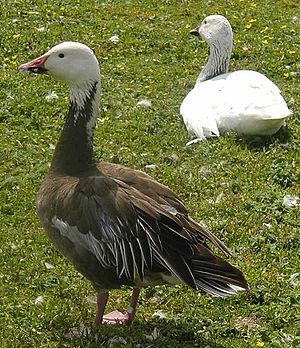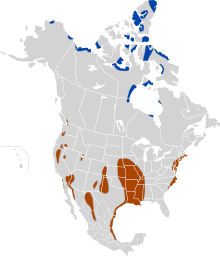Snow goose
| Snow goose | ||||||||||||
|---|---|---|---|---|---|---|---|---|---|---|---|---|

Snow goose ( Anser caerulescens ) |
||||||||||||
| Systematics | ||||||||||||
|
||||||||||||
| Scientific name | ||||||||||||
| Anser caerulescens | ||||||||||||
| ( Linnaeus , 1758) |
The snow goose ( Anser caerulescens ) is a real goose belonging to the field geese and thus belongs to the family of duck birds . According to recent molecular genetic studies, it is sometimes placed in its own genus ( Chen ). The species was first described by Carl von Linné in his work Systema Naturae in 1758 . A distinction is made between the small snow goose ( A. c. Caerulescens ) and the large snow goose ( A. c. Atlanticus ). The little snow goose also has a natural color mutation that has blue-gray plumage. This is also known as the blue snow goose. The dark plumage is inherited dominantly. Snow geese, however, show a preference for mating with partners of the same color, so that the recessive white form is retained.
features
There are two phases of coloration of the snow geese. One is snow-white except for the black hand wings and the ash-gray hand covers. The other is colored blue-gray except for the white head and neck and the light and white rear abdomen. Because of these color variants, in addition to the species subdivision, there is also an additional classification based on the colors:
- white phase (white morph),
- dark or blue phase (dark morph).
There are also transitions between the white and blue phases. In both phases, the geese's beak is red and black. The feet are reddish. The relationships between the two color variations are quite intricate. However, both variants sometimes occur as descendants of the same set of parents.
In the snow geese, males and females look very similar, the young are mostly grayish in color. Snow geese are about 60 to 75 cm long, have a wingspan of 150 cm and weigh 2.5 to 4 kg. They can live up to 20 years.
Her reputation is a soft, slightly rising and cackling go go go , also koik or goaa and gä-gä-gä . Warning calls are lower in volume and sound like angk-ak-ak-ak . The flight call is monosyllabic, short and rough and is circumscribed onomatopoeically with krä or kähk .
habitat
The snow goose breeds in northwestern Greenland , northern Canada and northeastern Siberia , but as a migratory bird spends the winter further south, especially in the United States , but occasionally even further south. They are also rarely found in Europe . As a rule, these geese are refugees from captivity and less often wanderers . In Europe they usually socialize with other wild geese. Snow geese often gather in large flocks, sometimes many thousands of birds.
The south migration usually starts in late August and early September. They reach their wintering places from the beginning of October. The northward migration begins in February and has its peak at the beginning of April. They reach their breeding grounds in late May.
food
In the summer breeding area, arctic grasses form the basis of the food. In arctic Canada, for example, the Carex stans sedge plays an important role in the geese's diet. The vegetative parts of Dupontia fischeri and Pleuropogon sabini play an important role on Wrangel Island . Basically, however, they are very flexible in their diet and will eat any plant. This also includes the leaves and shoots of willow, moss and lichen. Small saltwater and freshwater invertebrates also have a small share in the diet. In the wintering area they also eat seeds and pieces of roots.
Reproduction
Males and females unite for life. In its entire reproductive cycle, the snow goose is prepared for the short arctic summer. The breeding season does not begin until around the end of May due to the arctic summer climate. The animals arrive at their destination already paired and start building their nests immediately . At that time, their urge to reproduce is so high that they often lay eggs on the coast on the way to the breeding grounds.
Snow geese are colony breeders. Large parts of the population use permanent breeding grounds. On the Siberian Wrangel Island , for example, the main colony is a dry lowland area surrounded by mountains, about 20 kilometers from the coast. The upper reaches of the Tundrawoja River and several smaller streams run through them . The 13 × 14 kilometer lowland is relatively sheltered from the wind and interspersed with small areas of grass. The nesting density is more than 90 nests per hectare in many places that are clear of snow early. In places where the snow thaws relatively late, the nest density drops to three to four nests per hectare. The vegetation is also due to the constant fertilization by the geese a little more lush and is characterized by 20 to 30 centimeter high willow bushes and a dense vegetation with dryas punctata .
The nests are created in hollows in the ground and lined with lichen and smaller plant parts, and inside with down feathers . The female lays around 4 to 6 white matt-glossy eggs in early June and incubates for around 21 days. This is a relatively short breeding season. After hatching, the young birds need about six weeks to fledge. At the same time, the parent birds are moulting . Similar to the short breeding season, the moulting process is also adapted to the short arctic summer. It takes place within a relatively short period of time. In contrast to other geese, moulting occurs simultaneously in both breeding and non-reproductive geese. At the end of August they and their young are able to fly again and move to their wintering area. One- and two-year-old birds that have not yet incubated themselves usually stay with their parents. At the age of three, the young birds themselves reach sexual maturity.
Subspecies
The snow geese are divided into two subspecies (nominate forms), which differ from each other mainly in size:
- Great snow goose ( A. caerulescens atlanticus )
- Little snow goose ( A. caerulescens caerulescens )
In contrast to the large snow goose, the small snow goose is very common.
Danger

The species as a whole is currently not endangered. In Japan, where it was once abundant, it has now become rare. The stocks on Wrangel Island are also falling sharply. In Northeast Asia their range has changed significantly. Snow geese were still very common in the tundras of Siberia in the 18th century. Their breeding area even reached the mouth of the Ob . Since the first quarter of the 19th century, North Asia has seen a decline in populations and a reduction in the breeding area. It is now completely absent in parts of mainland Asia and a number of North Asian islands.
The snow goose is the most common type of goose found in North America, along with the Canada goose. Since the 1960s it has shown very strong growth rates in North America. In the late 1960s, the estimated world population was 1.6 million individuals. In 1995 there were five million snow geese in North America and another 70,000 in Siberia. In some of its breeding areas it has already reached maximum population density. The sensitive turf here occasionally shows signs of overgrazing.
Snow geese and humans
For the peoples of Northeast Siberia in particular, the snow goose was of great economic importance. Snow geese have been hunted constantly and regularly over the centuries. Hunting these ducks was very easy, as the animals brooded in large colonies in specific places. In addition to killing flightless moulting birds, egg collection was also practiced for centuries. Settlement of the American West presumably also contributed to the population decline. This region is one of the wintering areas of large parts of the Siberian snow geese. There, too, heavy hunting began in the 19th century. According to eyewitness accounts, a single hunter was able to kill thousands of snow geese in one winter half year. With the reclamation of the North American prairie , this species lacked the usual wintering places.
Snow geese in Germany
For 2005, 4–5 breeding pairs were reported from Germany which were descended from breeding animals that had escaped. For Germany, elimination (catching and shooting) is required so that no larger populations build up. For 2010, 81 adult birds with 21 young birds were reported for Lake Jröne Meerke near Neuss . In 2012, a feeding ban was imposed on the Jröne Meerke because of the faeces of the geese. In addition to the snow geese, there are also large numbers of gray geese , Canada geese and white-fronted geese at the lake . It was feared that the goose droppings in the water could cause excessive eutrophication and, as a result, algae plague . It was also suspected that germs such as salmonella and E. coli bacteria contained in the excrement could transmit diseases to human visitors to the park on the lake. A children's playground by the lake was closed due to a possible risk of infection. Individual geese at the lake were killed or injured by dogs running free.
literature
- Jonathan Alderfer (Ed.): Complete Birds of North America , National Geographic, Washington DC 2006, ISBN 0-7922-4175-4
- Erich Rutschke: Wild geese. Way of life - protection - use . Parey, Berlin 1997, ISBN 3-8263-8478-4
- Hartmut Kolbe: The world's ducks. 5th edition. Ulmer, Stuttgart 1999, ISBN 3-8001-7442-1
- SM Uspenski: Die Wildgänse Nordeurasiens , Westarp Wissenschaften-Verlagsgesellschaft, Hohenwarsleben 2003, reprint of the 1st edition from 1965, ISBN 3-89432-756-1
Web links
- Videos, photos and sound recordings about Anser caerulescens in the Internet Bird Collection
- Anser caerulescens inthe IUCN Red List of Threatened Species 2013.2. Listed by: BirdLife International, 2012. Retrieved November 23, 2013.
Individual evidence
- ↑ a b c Alderfer, p. 6
- ↑ Kolbe, p. 113
- ↑ Hans-Heiner Bergmann; Hans-Wolfgang Helb; Sabine Baumann; The voices of the birds of Europe - 474 bird portraits with 914 calls and chants on 2,200 sonograms , Aula-Verlag, Wiesbaden 2008, ISBN 978-3-89104-710-1 , p. 41
- ↑ Uspenski, p. 11
- ↑ Upsinski, p. 8
- ↑ Upsinski, pp. 9 and 10
- ↑ Uspenski, p. 9
- ↑ Alderfer, p. 7
- ↑ Uspenski, p. 5
- ↑ Kolbe, p. 114
- ↑ a b Uspenski, p. 7
- ↑ Klemens Steiof: Action requirements in dealing with non-native and invasive bird species in Germany . Reports on bird protection 47/48, 2011: 93–118.
- ^ Team collective report: Remarkable birds in North Rhine-Westphalia in 2010 . Charadrius 2011, 47/4: 226-290.
- ↑ Hanna Koch: The geese from the Jröne Meerke . In: Neuss-Grevenbroicher newspaper . May 13, 2011 ( full text in the NGZ's online archive ).
- ↑ Daniela Ullrich: Goose plague at the lake Jröne Meerke . In: Westdeutsche Zeitung . July 9, 2012 ( full text in the WZ online archive ).




